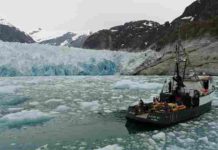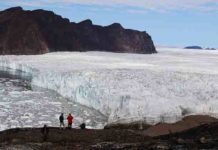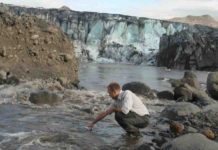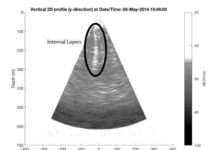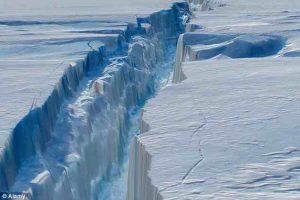
Glaciologists have uncovered large valleys in the ocean floor beneath some of the massive glaciers flowing into the Amundsen Sea in West Antarctica. Carved by earlier advances of ice during colder periods, the troughs enable warm, salty water to reach the undersides of glaciers, fueling their increasingly rapid retreat.
“These oceanic features are several hundreds to a thousand meters deeper than what we thought before,” said Romain Millan, a graduate student in Earth system science at UCI and lead author of the new study. “It gives new insight into the future fate of these glaciers and the potential influence of warm ocean water that can melt away ice from below.”
The discovery is the result of an analysis of gravity data from airborne NASA Operation IceBridge missions from 2009 to 2014 combined with ice motion measurements made by researchers at the University of California, Irvine (UCI), UCI’s own mass conservation algorithm, and existing bed topography and ice thickness information. The new study has been accepted for publication in Geophysical Research Letters, a journal of the American Geophysical Union.
In the new study, the researchers paid particular attention to sub-ice-shelf cavities in front of the Pine Island, Thwaites, Smith and Kohler glaciers in an area known as the Amundsen Sea Embayment. By obtaining a more high-resolution map of the ocean floor below the glaciers, they were able to detect an unmistakable cavity beneath the Pine Island Glacier and a slightly shallower depression beneath Thwaites Glacier.
“Based on our research, we now have a much clearer picture of what is hiding under these large glaciers located in a particularly vulnerable sector of West Antarctica,” Millan said.
Millan said the study’s most important findings were the gigantic submarine valleys under the Crosson and Dotson ice shelves. The channels start 1,200 meters (3,900 feet) below the masses of ice and slope up to points 500 meters (1,600 feet) beneath Crosson and 750 meters (2,500 feet) beneath Dotson.
Should glaciers in the Amundsen Sea Embayment region of Antarctica completely collapse, the researchers said, the global sea level could rise an additional 1.2 meters (4 feet). As bad as that sounds, they noted, there are some features of the ocean floor topography that might work to slow down the process of glacier retreat.
“We’ve revealed that West Antarctic glaciers include natural pathways for water intrusion, but all water sources are controlled by a 700-meter-deep [2,300-foot-deep] sill which blocks access to the truly warmest waters,” said Eric Rignot, a professor of Earth system science at UCI and co-author of the new study. “This is good news in terms of having these glaciers not fully exposed, but it makes the projections more challenging because all tiny details will be important in controlling ocean heat access to the glaciers.”
He said the findings will be instrumental in guiding future investigations of this region of Antarctica, in particular a major study of Thwaites Glacier by the National Science Foundation and the United Kingdom’s Natural Environment Research Council scheduled for 2018 to 2023.
Reference:
Romain Millan et al, Bathymetry of the Amundsen Sea Embayment sector of West Antarctica from Operation IceBridge gravity and other data., Geophysical Research Letters (2017). DOI: 10.1002/2016GL072071
Note: The above post is reprinted from materials provided by American Geophysical Union.







